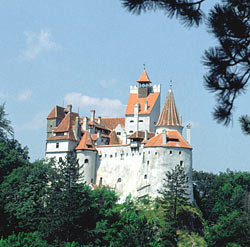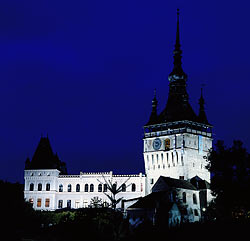Arefu
Where: 104 miles northwest of Bucharest / 11 miles north of Curtea de ArgesNote: access by car only
Next visit Arefu, where many of the villagers trace their ancestry back to the loyal minions of Vlad Tepes himself (in the movies, these are the ones who are always busy loading up Dracula’s coffins with Transylvanian earth). Legend has it that when the Turks attacked and took over the Poenari Castle in 1462, it was the villagers of Arefu who helped Vlad escape. Spend the night with the locals camping around a fire and listening to centuries-old folk tales. Homestays and B&Bs are available in Arefu and nearby villages.
 Brasov
Brasov
Where: 100 north of BucharestNearest train station: Brasov
Fringed by the peaks of the Southern Carpathian Mountains and resplendent with gothic, baroque and renaissance architecture, as well as a wealth of historical attractions, Brasov is one of the most visited places in Romania. Founded by Teutonic Knights in 1211 on an ancient Dacian site and settled by the Saxons as one of their seven walled citadels*, Brasov exudes a distinct medieval ambiance and has been used as a backdrop in many recent period films.
Sighisoara
Where: 170 northwest of Bucharest
Nearest train station: Sighisoara
Founded by Transylvanian Saxons during the 12th century, Sighisoara still stands as one of the most beautiful and best-preserved medieval towns in Europe. Designated as a World Heritage Site by UNESCO, this perfectly intact 16th century gem with nine towers, cobbled streets, burgher houses and ornate churches rivals the historic streets of Old Prague or Vienna for atmospheric magic. It is the birthplace of Vlad Tepes (Vlad the Impaler), ruler of the province of Walachia from 1456 to 1462
Vlad Dracul’s House (Casa Dracula)
Address: Str. Cositorarilor 5
Tel: (265) 771.108
Open: Tue. – Sun. 10:00 a.m. – 3:30 p.m.; Closed Mon.
The Vlad Dracul House is located in Sighisoara’s Citadel Square, close to the Clock Tower. This ocher-colored house is the place where Vlad Tepes, the inspiration for Bram Stoker’s famous Dracula, was born in 1431 and lived with his father, Vlad Dracul, until 1435 when they moved to Targoviste. A wrought-iron dragon hangs above the entrance. The ground floor of the house serves as a restaurant, while the first floor is home to the Museum of Weapons.
Bistrita
Where: 265 miles northwest of Bucharest
Nearest train station: Bistrita
Located at the foot of the Bargau Mountains, not far from the Borgo Pass (Pasul Tihuta in Romanian) which connects the provinces of Transylvania and Moldavia, the town of Bistrita is one of the oldest in the region. Archeological findings indicate that the area has been inhabited since the Neolithic age, long before Bram Stocker chose it as the setting of his fictional Dracula’s castle. Saxon colonists, who settled here in 1206, helped develop the town into a flourishing medieval trading post. First mentioned in 1264 as Villa Bistiche, the name was later changed to Civitas Bysterce. Soon enough, Bistritz,as it was known to its German inhabitants, became one of Transylvania’s most important Saxon citadels (Siebenbürgens*).
Today, the old town’s quaint 15th and 16th century merchants’ houses, the remains of the 13th century fortress walls and a generally unhurried pace have preserved some of Bistrita’s medieval atmosphere.

No comments:
Post a Comment